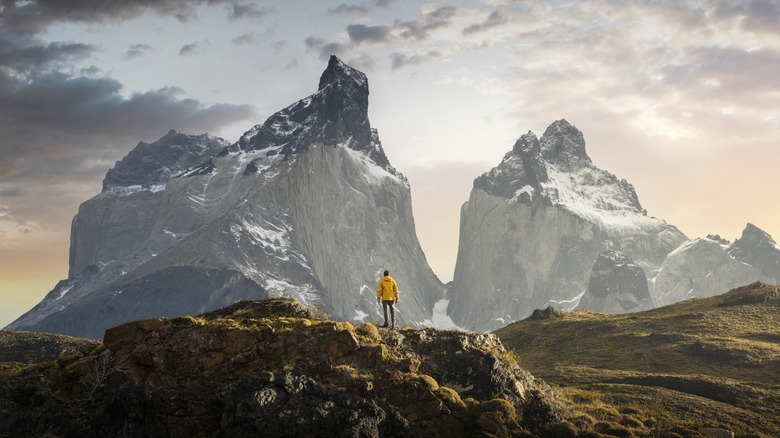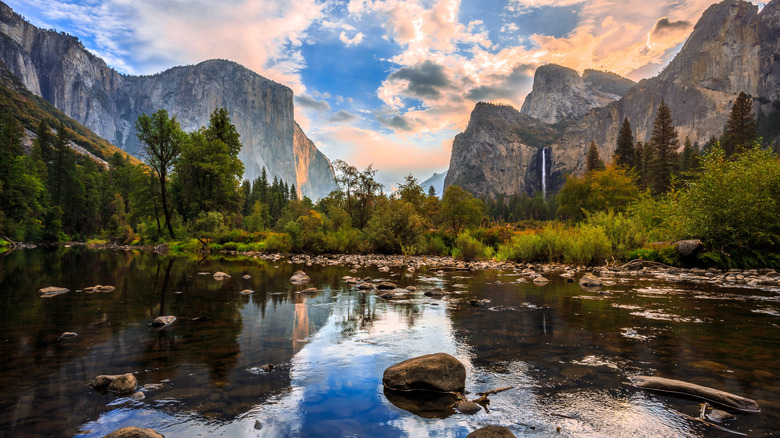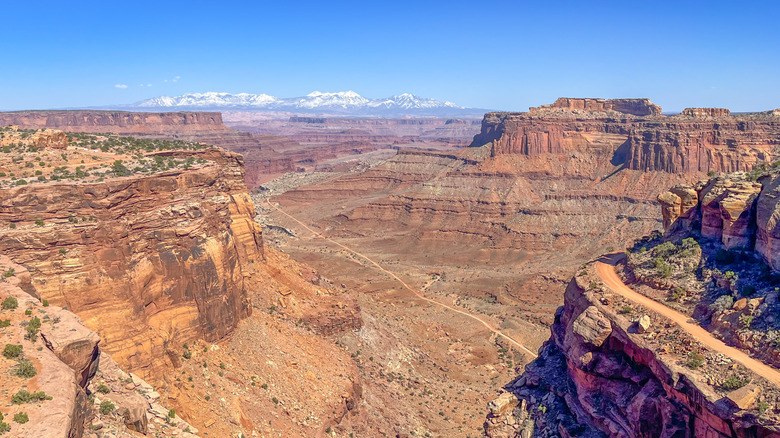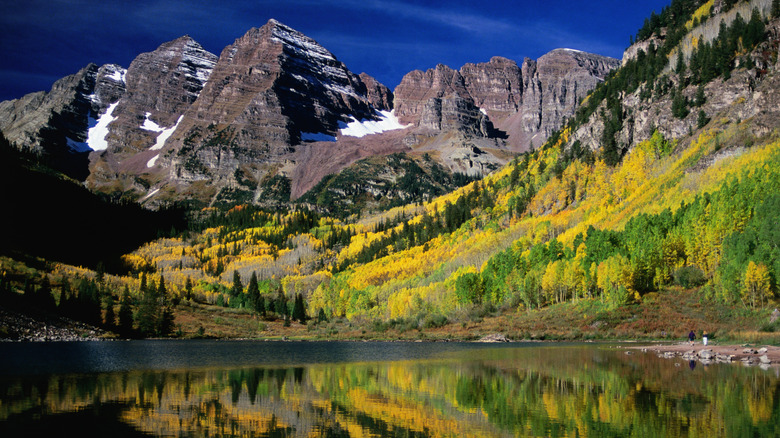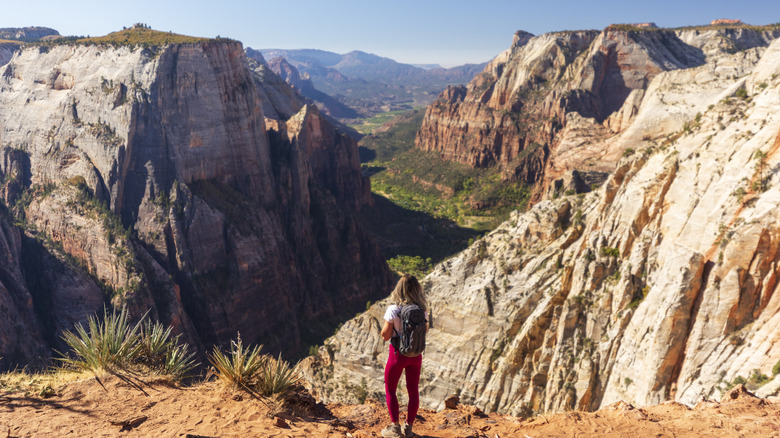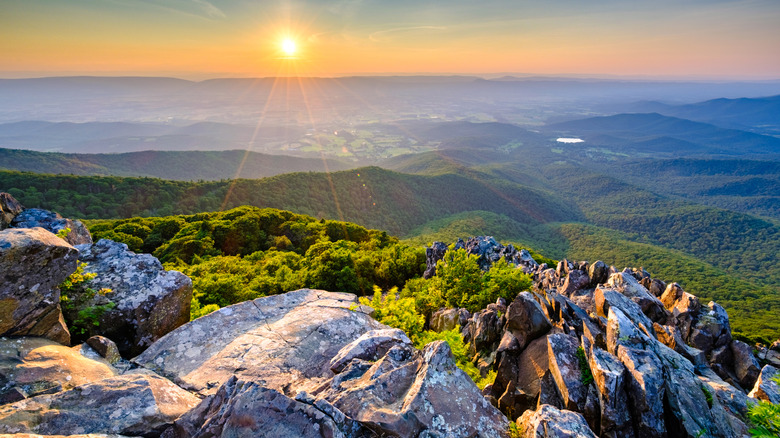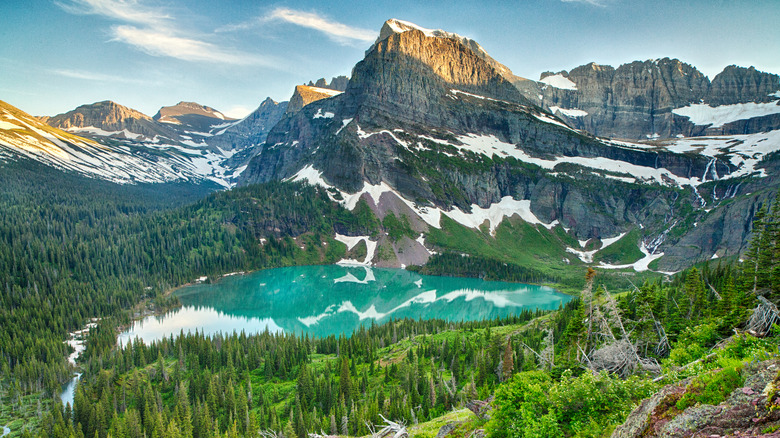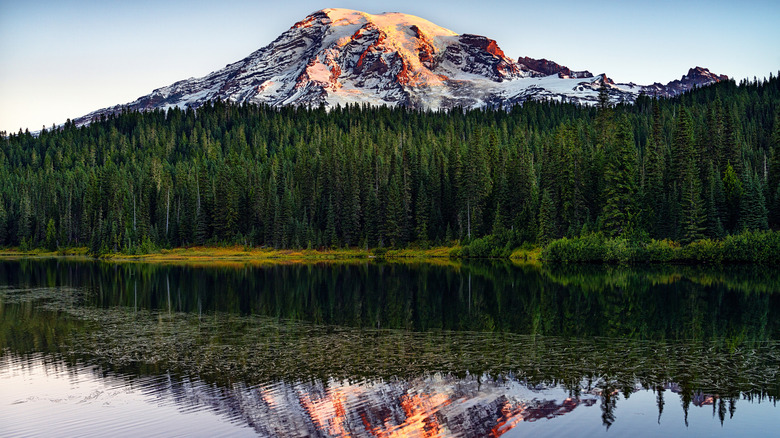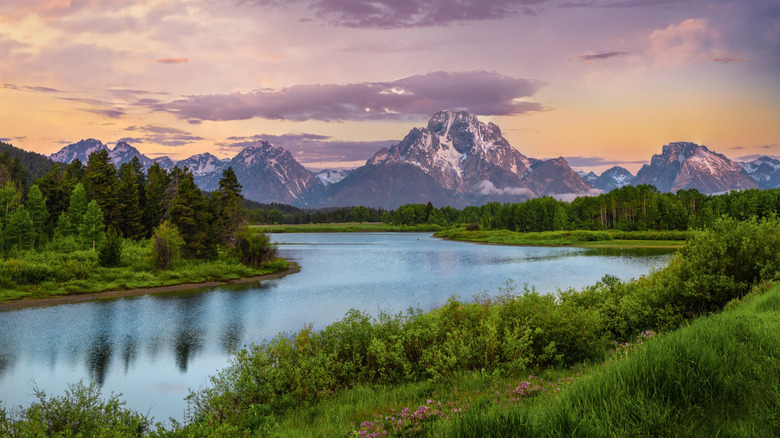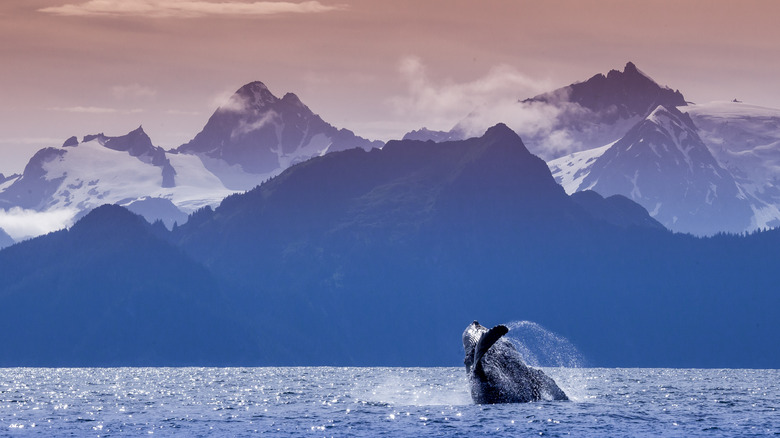National Parks In The US With The Most Challenging Hikes
Hiking in one of America's 63 national parks (and more than 400 NPS sites) is a great way to explore the nation's incredible wealth of environmental treasures. Across the country, stunning sceneries provide a laundry list of the most beautiful landscapes in the United States. Whether you're a hiker, camper, or just looking to get out into the natural world for a change of pace, heading away to one of the country's national parks is a phenomenal way to spend your free time.
Hikers have it particularly good when it comes to the National Park System. These parks feature hundreds of marked trails, combining to provide thousands of hikeable landscapes in some of the most breathtaking settings you'll find anywhere on the planet. Many of these trails are great for novices with little to no experience with the demands of a lengthy hike. But others are perfect for experienced trailblazers looking for a quality outdoor challenge.
Some of the best national parks' hiking trails are rated hard and live up to that moniker. Whether it's felt in precipitous elevation change or the result of a lengthy, potentially multi-day voyage, these national parks support some of the most difficult hiking trails in the United States. They aren't for the faint of heart, but every one of these parks and their hiking landscape will deliver an immensely rewarding experience if you're up for the challenge.
Grand Canyon National Park, Arizona
Grand Canyon National Park, a.k.a America's most filmed national park, features a trail that's potentially the hardest singular hike in any national park in America. The Rim to Rim to Rim hike of the Grand Canyon is a 43.1-mile round-trip adventure. It begins in the South Rim, where you'll climb down into the canyon, traverse to the North Rim, then turn around and navigate back to the South Rim. The total elevation change is more than 21,000 feet, making it a massively daunting undertaking even for experienced hikers. To top it off, those who attempt this feat treat it as a day hike.
Adventurers who are firmly prepared for a challenge but may not be able to endure the true extreme of a round-trip hike through the Grand Canyon might consider the comparatively "easier" Rim to Rim hike. Instead of completing the journey from one side to the other and turning around to voyage back the way you came, the Grand Canyon's one-way hike will see you cross the Canyon and end your adventure on the other side. The journey is still tremendously demanding and isn't for the inexperienced or moderately fit hiker.
Fortunately for novice hikers, the Grand Canyon is a great place to visit, even if you aren't planning on lacing your hiking boots. Tackling the Colorado River that runs through it by boat or standing at the top and admiring the 7,000-foot drop (8,800 feet at its maximum) from cliff to bottom that was carved over countless millennia can put you in an adventurous mood without the extreme physical toll of an intense canyon hike. See our tips for visiting the Grand Canyon without a car.
Yosemite National Park, California
Yosemite National Park is home to 116 hiking trails that begin with a strenuous rating and only become more demanding as you peruse the list of options available. It also features some of the most iconic climbing sites in the world. They're of great interest, particularly El Capitan, as seen in climbing documentaries like "The Dawn Wall," featuring free climber Tommy Caldwell, and "Free Solo," which follows Alex Honnold's pursuit of the first free solo route up the cliff face.
The toughest trails in the park reward hikers with spectacular views. The 16.5-mile John Muir Trail culminates at Half Dome and offers stunning valley views. The 13.5-mile Clouds Rest Trail to Clouds Rest leads to breathtaking granite formations. One of the most dangerous hiking routes here is the Mist Trail route, which brings hikers to Vernal and Nevada Falls. The hike is a 6.4-mile roundtrip excursion, but distance isn't the primary challenge. Instead, you'll need to rely on sturdy hiking shoes and even poles to keep your footing on the rugged and slippery terrain. Half Dome, on the other hand, demands about 12 hours and features over 5,000 feet in elevation gain.
Canyonlands National Park, Utah
Utah's largest national park, Canyonlands National Park, features 84 trails in total. The park has three distinct areas visitors will want to check out. The natural geography of the Green and Colorado Rivers separates the park into three sections: The Maze, The Needles, and Island in the Sky. Each section provides wonderful opportunities for visitors to get closer to nature and take in some of the park's most beautiful scenes.
If hiking is what you've come to Canyonlands for, its trails won't disappoint. Nineteen of its 84 routes are rated strenuous. The longest stretches across nearly 12 miles of Island in the Sky's landscape (Lathrop Trail, which brings hikers to the White Rim Road). There's also a 22.5-mile overnight trail in The Needles' Salt Creek Canyon. However, Druid Arch is one of the most challenging trails in Canyonlands.
The 10.8-mile Druid Arch trail takes up to about 7 hours. It traverses the base of Elephant Canyon, forcing hikers to contend with loose rock and deep sandy terrain before a steep incline that features a ladder to finish. Beyond the endless views of Utah's southern desert landscape, Canyonlands is a great place to go camping. (Or, perhaps, even enjoy a bit of elevated glamping with a few key upgrades to your basic campsite and packing list). The park is one of the most underrated natural sites in the country, with fewer crowds than others in the region.
Rocky Mountain National Park, Colorado
Rocky Mountain National Park cuts through Colorado and features 60 mountains that reach over 12,000 feet in altitude. The park's 109 trails naturally traverse this elevated scenery, introducing a unique element of difficulty that isn't always present elsewhere. Hallett Peak and The Keyhole on Longs Peak are two of the most immensely challenging hikes in the park.
The Hallett Peak hike starts at Bear Lake and covers an out-and-back layout for a 10.3-mile adventure showcasing phenomenal scenery like the Keyboard of the Winds, Pagoda Peak, and Longs Peak. Bluebird Lake Trail is another voyage that's well worth the sweat. You'll arrive at Bluebird Lake at the end of a 12.6-mile trek that climbs 2,490 feet in elevation. For all that effort, you'll be rewarded with a lake view overlooked by Ouzel Peak.
For the most experienced hikers, The Keyhole is a big deal. It's the park's only 14,000-foot trail (known as a fourteener); it introduces the perils of altitude sickness into the mix. This isn't just a hike in the classical sense. Braving the climb will see you navigate loose rock, narrow ledges, and even falling debris that can prove fatal. This trail delivers an altitude gain of over 4,000 feet along a 12.4-mile adventure that you won't soon forget if you manage to summit the mountain.
Zion National Park, Utah
Zion National Park's north-to-south ultra-day hike has become a cult classic among experienced hikers. Granted, only the fittest hikers will be prepared to handle this intense challenge. A direct hike from Lee Pass Trailhead to East Entrance Trailhead will bring you a 47-mile exploration of some of the park's most amazing scenery.
Along the way, there are additional side adventures to dig your teeth into. This gives the most dedicated hikers among us a deeply rewarding day in one of the most dramatically beautiful parks in the country that already features plenty of great reasons to visit. For those seeking only the hardest of trails, the Angels Landing hike has to be the most difficult that we (and we can't tackle more than 50 miles of total trailhead in a single day!) might actually consider.
Hikers looking to tackle this famous and popular hiking route will need a permit (one of many national park features that first-time visitors might not know requires a reservation). But once you've secured your credentials, all that's left is the excitement of the climb. Along the way, you'll explore Zion Canyon from above and navigate steep inclines, narrow pathways, and more. The out-and-back journey covers a roughly 4.3-mile trek filled with riveting suspense and more than a few breathtaking views.
Shenandoah National Park, Virginia
The Appalachian Trail runs partially through Shenandoah National Park. Of course, a thorough hike of the Appalachian Trail is among the hardest you'll tackle in any part of the country. But Shenandoah National Park is also known for some difficult hikes of its own. Old Rag is the toughest among the network of nearly 100 trails throughout this segment of the legendary Blue Ridge Mountains.
The Old Rag Circuit (a 9.4-mile hike) is rated very strenuous. It features a 2,348-foot elevation gain and demands a commitment of roughly 7½ hours to complete. You'll need to buy a $1 Old Rag day-use ticket between March and November to hike the challenging mountain. The experience includes rock scrambles and isn't for the faint of heart — especially for those bringing their dogs for the journey.
Alternative routes around the Old Rag Mountain are also in the cards. The Nicholson Hollow Trail, for instance, allows pets to accompany adventurers. The main trail meanders through a wooded area and opens up to an expanse of bare rock that continues upward to the 3,284-foot summit.
Glacier National Park, Montana
Glacier National Park is tucked away in the far north of Montana. However, the park is one of the most visited in the National Park System, with 3.2 million visitors heading to this fascinating landscape in 2024. Over 1 million acres of unbelievably beautiful forest make up an almost unfathomably picturesque landscape.
It also features 71 trails that hikers can embark upon to explore the 26 glaciers and 762 lakes nestled throughout its wilderness. Rugged mountain features naturally play a part in what you'll find here. Significant elevation changes that range up to 7,000 feet in climbing height make for some intensely challenging trails. The hardest among them are Sperry Glacier Trail, Grinnell Glacier Trail, and Highline Trail.
The Highline hike will send adventurers along a narrow path that works its way upward alongside mind-bending sights and plenty of steep cliffsides. Sperry Glacier Trail features a steep incline covering roughly the first half of the ascent across this 18.4-mile roundtrip adventure. The journey (via Gunsight Pass Trailhead) features an astounding elevation gain of 4,835 feet and will essentially take the entire day to complete. Those hoping to break up the voyage to make the arduous trail a little more accessible will want to snag a room or campsite reservation at Sperry Chalet or the Sperry Campground to make the journey to the top only an 8.2-mile roundtrip climb.
Mount Rainier National Park, Washington
Washington state is a haven for hikers and nature lovers of all varieties. Whether you're in the mood for a scenic drive or plan to camp in an ancient forestland, Washington has tremendous natural beauty and features any outdoor arena you may be seeking. The same goes for hikers looking to challenge themselves. Mount Rainier National Park is a phenomenal place to do just that. The mountain is an active volcano tucked in the Cascade Mountain Range. It features 68 difficult trails with some spectacular intensity found in hikes leading to destinations like Shriner Peak.
However, the hike to Camp Muir is noted as one of the absolute hardest trails in North America. Tackle this hike from the valley floor to the base camp (a launching point for the rest of the hike up to Mount Rainier's summit). You'll need to bring ice axes and crampons and be prepared for a rapid elevation change that sees you rise nearly 3,000 feet over the course of just 2 miles to end the hike.
For endurance fiends, the Wonderland Trail features a 93-mile loop that will bring you around the base of Mount Rainier. This is a solid option for those who don't want to summit the mountain and would rather stay lower. Even without the intense climb, this trail features plenty of elevation change as you make your way up and down the face of Mount Rainier (albeit at a lower altitude). A multi-day adventure perfect for a group of laid-back yet still experienced hikers, this is a great choice for those looking to remain closer to the quiet, forested base of the majestic volcanic peak.
Grand Teton National Park, Wyoming
The Wyoming National Park scene is truly loaded with options. Yellowstone National Park sits near the top of the state, and almost directly under it is another gem that hikers and campers will know well. Grand Teton National Park is named for the highest peak in its mountain range. The park features 73 difficult hiking trails with a strenuous rating, and the Paintbrush-Cascade Canyons Loop and Death Canyon hikes are among its most demanding.
The trail features a 4,000-foot change in elevation along a 20-mile hike that loops from String Lake Trailhead. This voyage takes a full day of hiking to complete, with an expected duration lasting as many as 14 hours on the move. The Death Canyon Trail is somewhat shorter, with a four- to six-hour time commitment, but features a number of jumping-off points that can significantly extend your exploration.
Both hikes are challenging but make for a fabulous day out in the wild. Be it an overnight camping experience while hiking to Phelps Lake or winding along the canyons and ending at Fox Creek Pass from the Death Canyon trail. What's more, Grand Teton National Park is one of the best places to encounter bears while hiking in the wilderness. Keeping this in mind is an important planning consideration for those who hope to spot these majestic yet potentially threatening creatures and those who hope to avoid them altogether.
Kenai Fjords National Park, Alaska
The final entry on this challenging list of dream hiking destinations is tucked in Alaska. Kenai Fjords National Park features a unique scenic landscape. Fjords are a geological rarity throughout the world, and they stand as the backdrop to some of the most awe-inspiring scenery for those lucky enough to visit places like Norway, Oman, Chile, and Alaska. The landscape is a result of glacial carving, and lakes created from the movement of glaciers and fjords are truly a sight to behold. It's particularly stunning to see the glacier fields that remain in the area where these silent ice sculptors once performed their work.
As with Kenai Fjords National Park, the aquatic landscape teems with glaciers (more than 30 of them standing in the Harding Icefield). This is the target of hiker's desires when tackling one of America's most challenging national park routes. The Harding Icefield Trail isn't long, with a roughly 8.5-mile roundtrip standing between the start and finish lines of a hiker's path. However, roughly 3,200 feet in changing elevation and a series of demanding terrain changes make it intensely difficult to navigate.
To make matters worse (or better, depending on your preference for pain!), the trail is well-known for shifting weather with unpredictable effects. It can snow here in the summer, and torrential downpours can be stirred up on even the brightest days. Thick forest meets treacherously rocky footing to create a tough hike that will reward you with seemingly endless views of majestic remnants of a lost time that harkens back to the last ice age.
